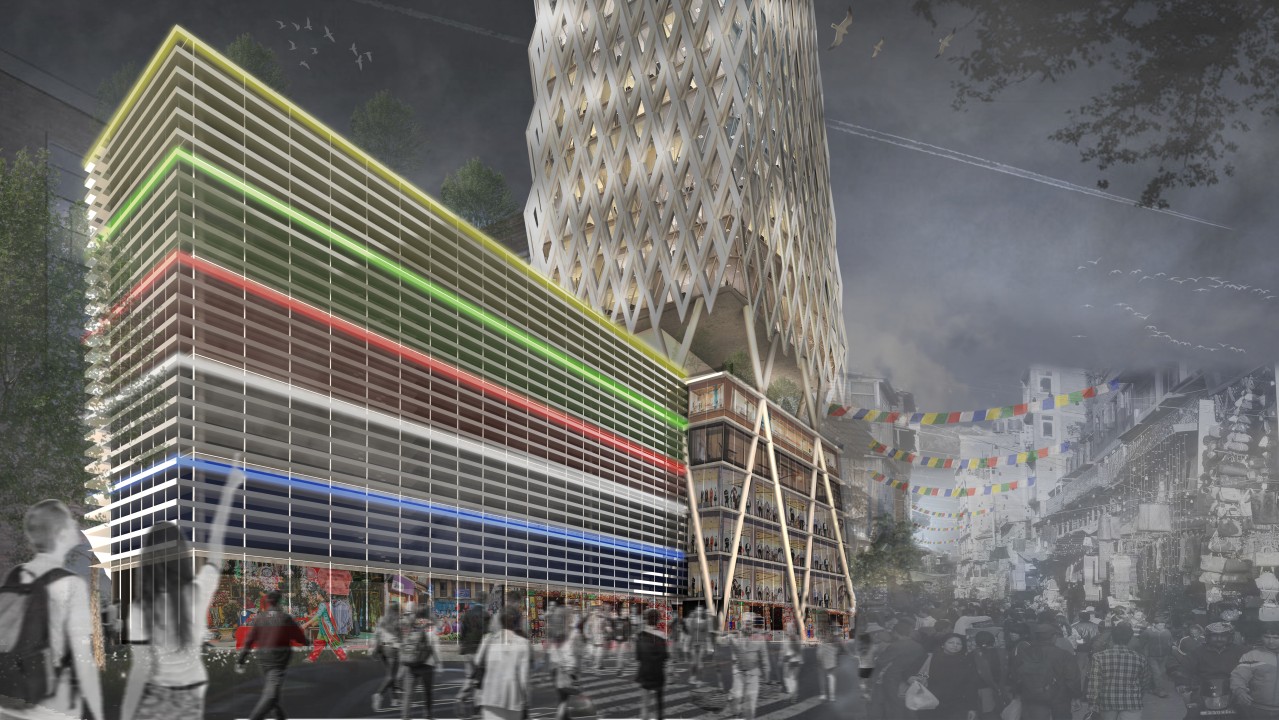Introduction
High-rise buildings dominate modern skylines, standing as symbols of urbanization and architectural innovation. Among the many elements that define these structures, the facade plays a pivotal role. It’s not just about aesthetics; the facade influences energy efficiency, occupant comfort, and even the building’s environmental footprint. In this article, we’ll dive deep into the world of facade high-rise buildings, exploring their design principles, materials, sustainability efforts, and the challenges architects face in crafting these towering giants.
Facade High-Rise Buildings: The Heart of Urban Architecture
Facade high-rise buildings are the visual representation of a city’s identity. They reflect cultural values, technological advancements, and aesthetic preferences. The facade serves multiple functions, including protection from the elements, energy efficiency, and aesthetic appeal.
The Role of Facades in High-Rise Buildings
Facades are more than just walls; they are the interface between the building and its environment. They regulate light, heat, and sound, significantly impacting the building’s energy consumption and the comfort of its occupants. A well-designed facade can reduce heating and cooling costs, enhance natural light penetration, and improve acoustic performance.
Key Functions of Facades
- Aesthetic Appeal: The facade is often the first thing people notice. A striking design can make a building an iconic part of the skyline.
- Energy Efficiency: Facades can be designed to minimize energy use through proper insulation, window placement, and shading devices.
- Environmental Protection: The facade protects the building from weather elements, contributing to its longevity.
- Sound Insulation: A well-constructed facade can mitigate external noise, creating a more comfortable indoor environment.
- Safety: Facades must meet safety standards, including fire resistance and structural integrity.
The Evolution of Facade Design in High-Rise Buildings
Historical Context
The concept of facades has evolved significantly over the years. Early skyscrapers featured simple, utilitarian designs, primarily focusing on structural integrity. However, as architectural styles evolved, so did the approach to facades. The Art Deco movement introduced intricate designs and decorative elements, while modernism favored minimalism and functionality.
Modern Trends in Facade Design
Today, facade design is at the intersection of technology and artistry. Architects are leveraging advanced materials and innovative technologies to create facades that are not only beautiful but also functional.
Sustainable Design
Sustainability is a key trend in modern facade design. Architects are increasingly incorporating green elements, such as living walls and solar panels, into their designs. This not only enhances the building’s aesthetic but also contributes to its energy efficiency.
Dynamic Facades
Dynamic facades are another exciting trend. These facades can change in response to environmental conditions, such as sunlight and temperature. For instance, some buildings feature movable panels that adjust to maximize natural light while minimizing heat gain.
Materials Used in Facade High-Rise Buildings
Choosing the Right Materials
The choice of materials is crucial in facade design. They must not only be aesthetically pleasing but also durable and functional. Here are some commonly used materials in high-rise facades:
- Glass: Glass facades are popular for their sleek appearance and ability to reflect light. They allow natural light to penetrate deep into the building, reducing the need for artificial lighting.
- Metal: Metals such as aluminum and steel are often used for their strength and durability. They can be shaped into various forms, allowing for creative designs.
- Concrete: Concrete is a versatile material that can be molded into different shapes. It provides excellent thermal mass and can be finished in various textures.
- Stone: Natural stone adds a touch of elegance to facades. It is durable and can withstand harsh weather conditions.
- Composite Materials: These materials combine two or more substances to create a product with enhanced properties. For example, fiber-reinforced polymers are lightweight yet strong, making them ideal for high-rise facades.
Sustainability in Facade High-Rise Buildings
The Importance of Sustainable Facades
As environmental concerns grow, the demand for sustainable building practices has increased. Facades play a critical role in a building’s overall sustainability. They can significantly reduce energy consumption and improve the building’s environmental footprint.
Strategies for Sustainable Facade Design
- Energy-Efficient Glazing: Using double or triple-glazed windows can greatly improve thermal performance, reducing heating and cooling costs.
- Green Roofs and Walls: Incorporating vegetation into the facade can improve air quality, reduce heat absorption, and provide insulation.
- Solar Panels: Integrating solar panels into the facade allows buildings to generate their own energy, contributing to sustainability.
- Rainwater Harvesting Systems: Facades can be designed to collect rainwater, which can be used for irrigation or other non-potable purposes.
- Recycled Materials: Using recycled materials in facade construction reduces waste and conserves resources.
The Impact of Facade Design on Building Performance
Thermal Performance
Thermal performance is a critical aspect of facade design. A well-insulated facade can significantly reduce energy consumption by maintaining a comfortable indoor temperature.
Insulation Techniques
- External Insulation: This involves adding insulation to the outside of the building, which helps to keep heat in during winter and out during summer.
- Internal Insulation: This method involves placing insulation on the interior side of the facade, which can be effective but may reduce usable space.
- Reflective Materials: Using reflective materials can help to minimize heat gain from sunlight, reducing the need for air conditioning.
Acoustic Performance
Acoustic performance is another vital consideration. High-rise buildings are often located in noisy urban environments, making sound insulation crucial for occupant comfort.
Sound Insulation Strategies
- Double-Glazed Windows: These windows provide an effective barrier against external noise.
- Acoustic Panels: Incorporating sound-absorbing materials into the facade can help to reduce noise levels inside the building.
- Strategic Layout: The arrangement of windows and other openings can also influence acoustic performance.
Challenges in Facade High-Rise Building Design
Structural Challenges
Designing facades for high-rise buildings presents unique structural challenges. The facade must be able to withstand wind loads, seismic activity, and other environmental factors.
Wind Load Considerations
High-rise buildings are particularly susceptible to wind forces. Engineers must calculate the expected wind loads and design the facade to withstand these forces without compromising aesthetics.
Maintenance Challenges
Maintaining facades can be challenging, especially for tall buildings. Regular cleaning and repairs are essential to ensure the facade remains functional and visually appealing.
Access Solutions
- Suspended Platforms: These allow maintenance crews to access the facade safely.
- Robotic Cleaners: Some buildings are now using robotic systems to clean their facades, reducing labor costs and improving safety.
The Future of Facade High-Rise Buildings
Innovations on the Horizon
The future of facade design is bright, with numerous innovations on the horizon. Architects and engineers are continually exploring new materials, technologies, and design strategies to improve the performance and aesthetics of high-rise buildings.
Smart Facades
Smart facades equipped with sensors and automation systems are becoming increasingly popular. These facades can adjust to environmental changes, optimizing energy use and occupant comfort.
Biophilic Design
Biophilic design, which aims to connect occupants with nature, is gaining traction in facade design. Incorporating natural elements into facades can enhance well-being and improve air quality.
FAQs
- What is a facade in high-rise buildings?
A facade is the exterior surface of a building, which serves both aesthetic and functional purposes, including energy efficiency and protection from the elements. - Why is facade design important?
Facade design is crucial because it influences the building’s energy efficiency, aesthetic appeal, and occupant comfort. - What materials are commonly used in facade construction?
Common materials include glass, metal, concrete, stone, and composite materials, each offering unique benefits. - How can facades contribute to sustainability?
Facades can enhance sustainability through energy-efficient glazing, green roofs, solar panels, and the use of recycled materials. - What challenges do architects face in facade design?
Architects face challenges related to structural integrity, maintenance, and ensuring the facade meets energy efficiency standards. - What trends are shaping the future of facade design?
Trends include smart facades, biophilic design, and the use of innovative materials and technologies to improve performance and aesthetics.
Conclusion
Facade high-rise buildings are at the forefront of architectural innovation, blending aesthetics with functionality and sustainability. As cities continue to grow and evolve, the importance of thoughtful facade design will only increase. By embracing new materials, technologies, and design philosophies, architects can create facades that not only enhance the beauty of urban landscapes but also contribute to a more sustainable future. The journey of facade design is ongoing, and the possibilities are as limitless as the skies these buildings reach for.


Leave a Reply